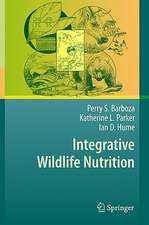Forest Wildlife Ecology and Habitat Management
Autor David R. Pattonen Limba Engleză Hardback – 12 oct 2010
Forest Wildlife Ecology and Habitat Management provides both foresters and wildlife biologists responsible for managing forest resources with an integrated understanding of the relationship between forests and wildlife. Based on David Patton’s 50 years of experience as a forester and wildlife biologist, the book shows readers how to look at forests as ecological systems and wildlife as part of the energy flow and nutrient cycling process within those systems. He offers readers a fundamental understanding of the natural processes that occur in a forest taking into consideration vegetation, water, and the natural effects of climate and time. He then provides a biological perspective on wildlife, discussing reproduction, behavior, feeding habits, and mobility. He also discusses the various influences on forests and wildlife by both natural and human-caused events.
Covering those forest types included in the U.S. National Atlas, and associating over 1,100 wildlife species with 20 major forest types in 48 states, Professor Patton provides recommendations for ways to restore and maintain wildlife habitat by direct and indirect coordination. Towards this end, the author —
- Evaluates various approaches to integrate forestry and wildlife management
- Offers a number of practical management strategies, emphasizing a progressive holistic approach
| Toate formatele și edițiile | Preț | Express |
|---|---|---|
| Paperback (1) | 370.25 lei 6-8 săpt. | |
| CRC Press – 27 sep 2019 | 370.25 lei 6-8 săpt. | |
| Hardback (1) | 599.24 lei 6-8 săpt. | |
| CRC Press – 12 oct 2010 | 599.24 lei 6-8 săpt. |
Preț: 599.24 lei
Preț vechi: 802.52 lei
-25% Nou
Puncte Express: 899
Preț estimativ în valută:
114.67€ • 120.12$ • 95.03£
114.67€ • 120.12$ • 95.03£
Carte tipărită la comandă
Livrare economică 08-22 aprilie
Preluare comenzi: 021 569.72.76
Specificații
ISBN-13: 9781439837023
ISBN-10: 1439837023
Pagini: 292
Ilustrații: 48 b/w images and 30 tables
Dimensiuni: 156 x 234 x 20 mm
Greutate: 0.57 kg
Ediția:1
Editura: CRC Press
Colecția CRC Press
ISBN-10: 1439837023
Pagini: 292
Ilustrații: 48 b/w images and 30 tables
Dimensiuni: 156 x 234 x 20 mm
Greutate: 0.57 kg
Ediția:1
Editura: CRC Press
Colecția CRC Press
Public țintă
Wildlife managers; wildlife and conservation biologists; ecologists; natural resource managers; forestry professionals/silviculturalists; forestry and wildlife professionals in government agencies and NGOs.Cuprins
Concepts and Theory Common Knowledge Axioms Wildlife in a Forest Environment of Forest Wildlife Plants in a Forest Water in a Forest Forest Diversity Vegetation Forests as Ecological Systems Forest Succession Healthy Forest Conditions Survive and Reproduce Hazards Diseases Predators Humans Biology Resources Integrating Forestry and Wildlife Management Toward a Common Perspective Forest Vegetation Forest Management Integrating Factors Wildlife Management Restore and Manage Resources and Diversity Management Strategies Ecosystems Wildlife Habitat Relationships Ecological Factors Habitat Models Habitat Evaluation and Monitoring Integrated Management The Menominee Paradigm Planning Inventory Sampling FAAWN: A Data Model for Forest Attributes and Wildlife Needs Database Management Systems The Data Model Design
Notă biografică
David R. Patton, PhD, Professor and Dean Emeritus, Northern Arizona University, Flagstaff, USA
Descriere
Combining concepts of forest and wildlife management, this book provides resources and research, practical field experience, and planning and inventory methods for sustaining forest wildlife populations. Beginning with background and definitions, it discusses land management activities, engineering, natural resource disciplines, and timber, wild


















